Email Automation
Definition
What is email automation?
Email automation is the process of scheduling and sending targeted emails automatically when triggered by specific dates, subscriber traits, or user behaviors.
Also known as triggered emails, it delivers the right message at the right time—enabling continuous, personalized communication without constant manual input.
By responding to actions like form submissions, website visits, or app interactions, automated emails can arrive precisely when they’re most relevant, boosting both engagement and ROI.
The benefits of email automation
Email marketing has grown to a $3+ billion dollar industry and, with 75% of consumers choosing retail brands with personalized messaging, offers, and experiences, personalized email automation remains largely untapped. Here are four benefits of email automation:
- Trust drives impulse: 49% of U.S. shoppers said that in the past three months they bought a product they did not initially intend to buy after a brand made a personalized recommendation.
- Personalization is the ultimate influencer: 70% of consumers saying a company’s understanding of their individual needs influences their loyalty.
- Switching costs don’t matter: 52% of customers say that they are extremely or somewhat likely to change brands if a company doesn’t personalize its communication with them.
- Loyalty = Personalization: 58% of consumers would switch half or more of their spending to a provider that excels at personalizing experiences without compromising trust.

So how do you start to use email automation to grow your business?
How to grow your business with email automation
The opportunities to personalize your customer’s experience are nearly endless. Why? With email automation, you set up triggers based on activities, dates, and other events that tell your system what to send them next. Because of this, you’re only bound by your level of creativity. If you’re just getting started, here are four ways to grow your business with email automation:
1. Increase revenue
Email automation is one way to quickly increase your revenue. With 75% of online shoppers abandoning their carts, sending an automated cart abandonment email can help get 10%+ to come back and buy. Or, if you’re selling information products, recommending a discounted product immediately post-purchase can drastically increase your topline revenue.
Read more on:
2. Increase customer retention
With the majority of customers ready to switch to whatever brand best understands them, customer retention must become a priority. Additionally, it’s easier to sell to an existing customer than to convert a new one. A well-timed (and of course, automated) re-engagement email can be all you need.
3. Saves time and scales your team
The biggest benefit of email automation is that it doesn’t require much of your time. There’s no reason to limit the number of emails you can send by how large, or small, your team is (or if you have a team at all). Email automation allows you to send emails while you sleep, scaling your team and saving you time. Once you’ve set up your emails, you can continue to focus on processes that can’t be automated (yet)!
4. Keeps you ahead of the competition
According to LeadSpace, 82% of companies rely on some form of automation. The question is no longer whether or not to use automation, but who is using it best. If you want to stay ahead of the competition, smarter email automation is key.
How to make your email automation more effective
Not sure where to start with implementing email automation? While there is definitely a time and place for mass broadcast emails you may already be sending, these six tips will help you get started with immediately improve your email automation:
- Drip campaigns
- Write great email preheader
- Structure for scanners
- Copywriting matters
- CTA buttons
- Strategic opt-outs
1. Drip campaigns
Drip campaigns are a series of marketing emails sent out on an automated schedule. Typically used by a business to nurture leads through a sales or marketing funnel, content is “dripped” out to the subscriber based on specific triggers. When certain conditions are met, the drip campaigns are triggered to be sent out to help educate, empower and/or entertain the subscriber until they are ready to make a purchase.
2. Write great email preheader
Email automation can be a “set and forget” process, but like all emails, they’re only valuable if they get opened. Naturally, this starts with a compelling subject line, but an important (and often ignored) addition is the email pre-header:

Pre-headers are most effective when they build curiosity gaps established in the subject. Need more inspiration? Click here to check out our email subject line generator and our guide to email subject line testing.
3. Structure for scanners
Most people don’t read every word in your emails. They scan them for relevant topics they’re interested in. They do the same thing in blog posts. Maybe you scanned down to this very section because you already knew what email automation is and why it’s valuable. By breaking your email into chunks, either with headers or formatting, readers can find the sections that matter most to them, making them more likely to click, and more likely to open your emails in the future.
4. Copywriting matters
Similar to writing a landing page, writing copy for your emails is extremely important. The best landing pages explain: One business objective One emotional objective One action objective Emails can (and should) be similar. Akin to the PAS formula (problem, agitation, solution), this new formula adds emotional gravity to help guide them to take action.
Read more on:
5. CTA Buttons
Adding a Call to Action (CTA) button, instead of just text links, can increase clicks up to an additional 158%. With most emails being viewed on mobile devices, adding a large button (or obviously button-esque image) can increase the CTR of your email automations.
6. Strategic opt-outs
Certain holiday promotions can hit your subscribers harder than others. So, as a part of your email automations, it’s recommended to build in strategic “opt-outs” so subscribers can stay on your email list without receiving triggering emails. Here’s a great example from Free Fly Apparel:
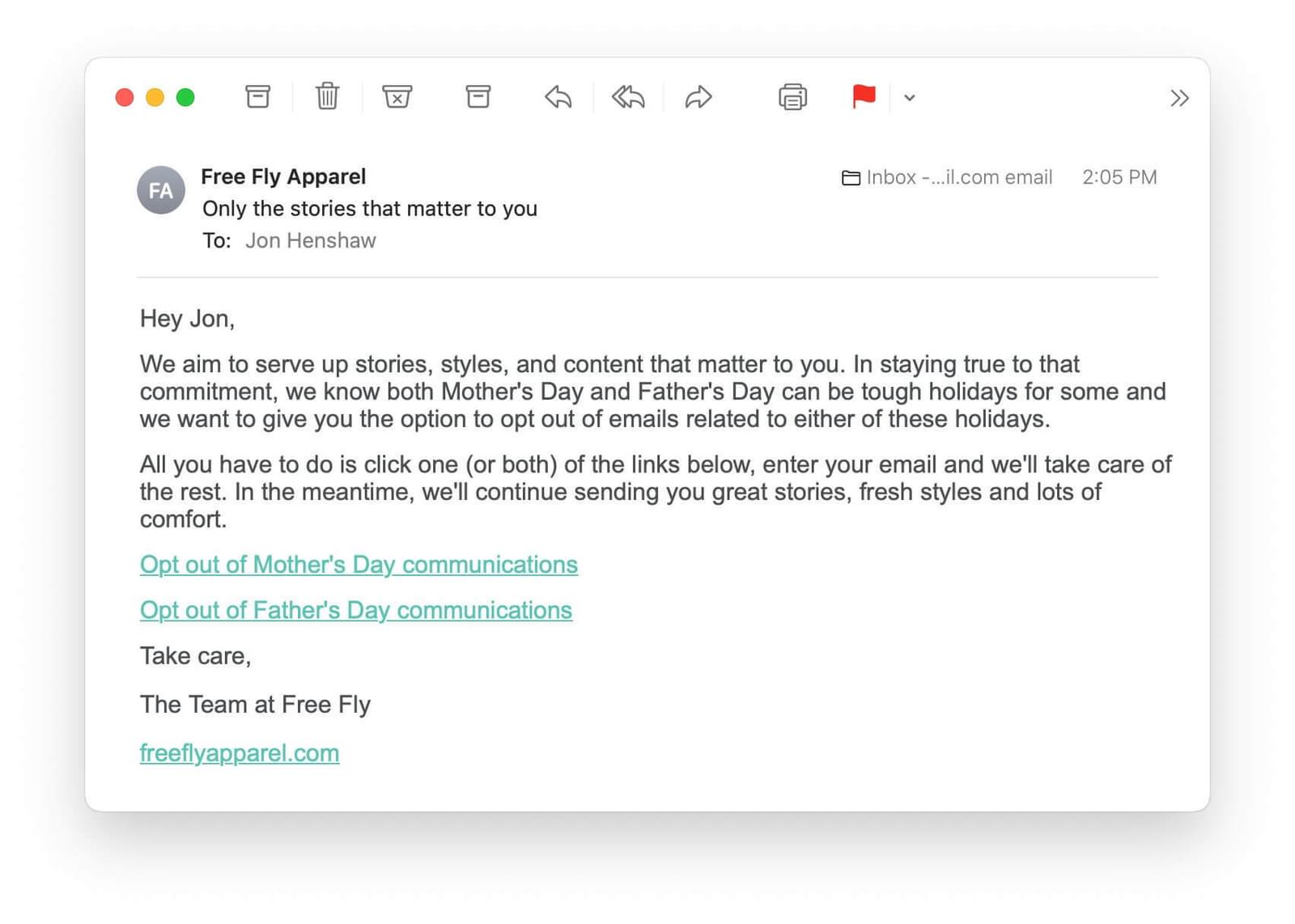
Email automation examples
Ready to get started? Here are 7 email automations you can start today!
1. Welcome email series
Subscribers are most engaged when they first join your email list. Here’s a 4-part welcome email series:
- The Dinner Party Strategy — A warm welcome and some simple expectation-setting
- The Expertise Setter — Show them the value of being a subscriber
- The I-Make-Genius-Look-Easy Lesson — Teach them to do what you do for your clients
- The Self-Segmenter — Segment your subscribers and send them relevant emails
2. Product update emails
Many ecommerce businesses email their customers when products are new or back in stock, but very few are using one of the most powerful email automation tools: dynamic content. Dynamic content changes based on your subscribers’ behaviors and preferences. With the ability to change text, visuals, and even CTAs based on that data, you can send product inventory updates based on things like occupation, past purchases, and even the weather. For example, Hipcooks uses segmentation to identify geography and makes recommendations based on what’s in season in that area.
3. Newsletters
Often, newsletters are thought of as being similar to broadcast emails. They’re written once and sent once. But what about your greatest hits? What about the timeless newsletters and great emails that have really resonated with your audience? Can’t those be sent again, automatically? Peter McPhersonthinks so: “Why can’t you create a fully automated & evergreen newsletter that nurtures, segments, and monetizes your audience… 24/7?” he asks.
4. Re-engagement automations
You lose a quarter of your subscribers every year. Many of those are to people unsubscribing, but another 10-20% go dormant and stop opening your emails for one reason or another. By setting up a re-engagement email sequence, you can start to reclaim those subscribers. Click here to see re-engagement email automations you can instantly add to your ActiveCampaign account
5. Repeat customer automations
Your best customers are people who already know, like and trust you. Automatically sending them emails that upsell and cross-sell your products and services is something they’ll appreciate. How? Here’s a two-part email automation you can set up today: Check in — 2 to 3 days after a customer should have received their purchase, check in to see how everything went and how they’re enjoying their product Be helpful — 4 days after that, send product recommendations that align with their purchase (and better yet, enhance their purchase). Or show them social proof that they made a great purchase. Reminding your customer that what they just bought is valuable and helpful helps them emotionally reaffirm their purchase. Click here to see our TOP repeat customer email automation that you can instantly add to your ActiveCampaign account
6. Win-back email automations
Similar to repeat customer and re-engagement automations, sometimes subscribers have bought something from you and stop opening your emails. This type of campaign is often referred to as a “win back” email campaign. The key to a winning “win back” campaign is not only to let the customer know why you miss them (definitely start with that), but remind them why they should miss you. Show them the successes they’ve had with your product, products they’ve purchased and enjoyed and more. Here’s a great example from Teespring:

Click here to see win-back email automations you can instantly add to your ActiveCampaign account
7. Cart abandonment email automations
Customers leave your website before purchasing all the time, but what if we could help them still make a purchase? An abandoned cart email automation is a great way to do it. The best ones are three emails that highlight the items they left in their cart. The key? Timing. Here’s how to set that up:
- First reminder – sent after 24 hours
- Address possible product objections – sent after 48 hours
- Incentivize them with a discount – sent after 72 hours

Click here to see cart abandonment automations you can instantly add to your ActiveCampaign account
5 best email automation tools
These are 5 of the top email automation platforms to consider:
1. ActiveCampaign
ActiveCampaign is a comprehensive marketing automation suite that allows you to automate advanced marketing campaigns incorporating email, SMS/text messages, sales outreach, and lead scoring in the built-in customer relationship management (CRM) system. It’s a robust tool with a range of plans for businesses of all sizes.
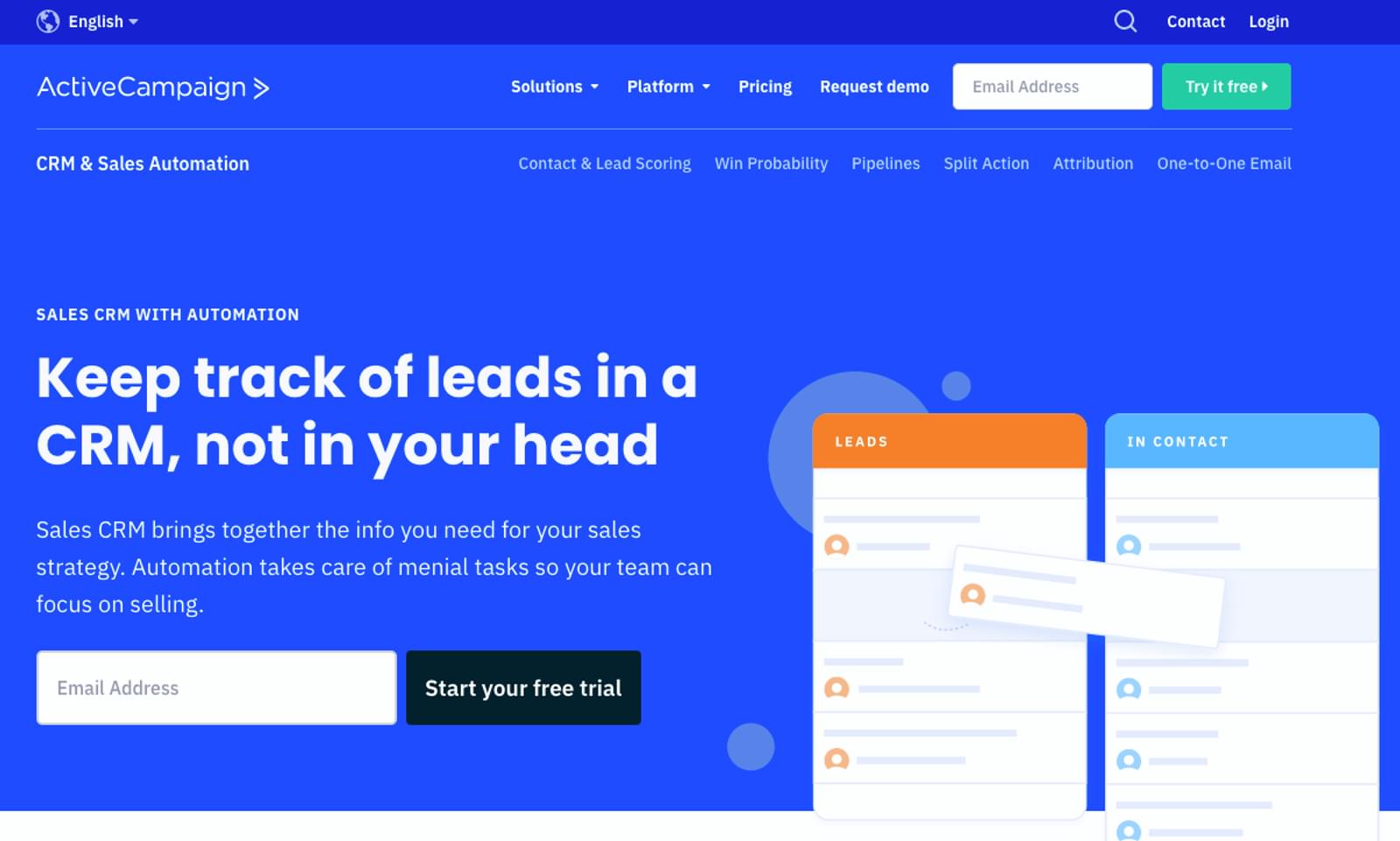
Homepage of ActiveCampaign website
Email automation in ActiveCampaign:
- Cross-channel automation: With ActiveCampaign, you can create multi-channel and even omnichannel automated marketing campaigns, connecting email, ecommerce, social media, and SMS for the best customer experience.
- 800+ automation recipes: Users have access to hundreds of pre-built email workflows and other automations.
- Transactional emails: ActiveCampaign integrates with major ecommerce platforms to automatically deliver confirmations and other transactional emails.
- Automated lead scoring: Along with email marketing campaigns, ActiveCampaign allows you to automate lead scoring and other sales and marketing tasks.
2. GetResponse
GetResponse is a marketing software specializing in inbound marketing. It supports engagement across multiple channels, including email, SMS, and chat. It offers landing pages and some content creation tools as well.
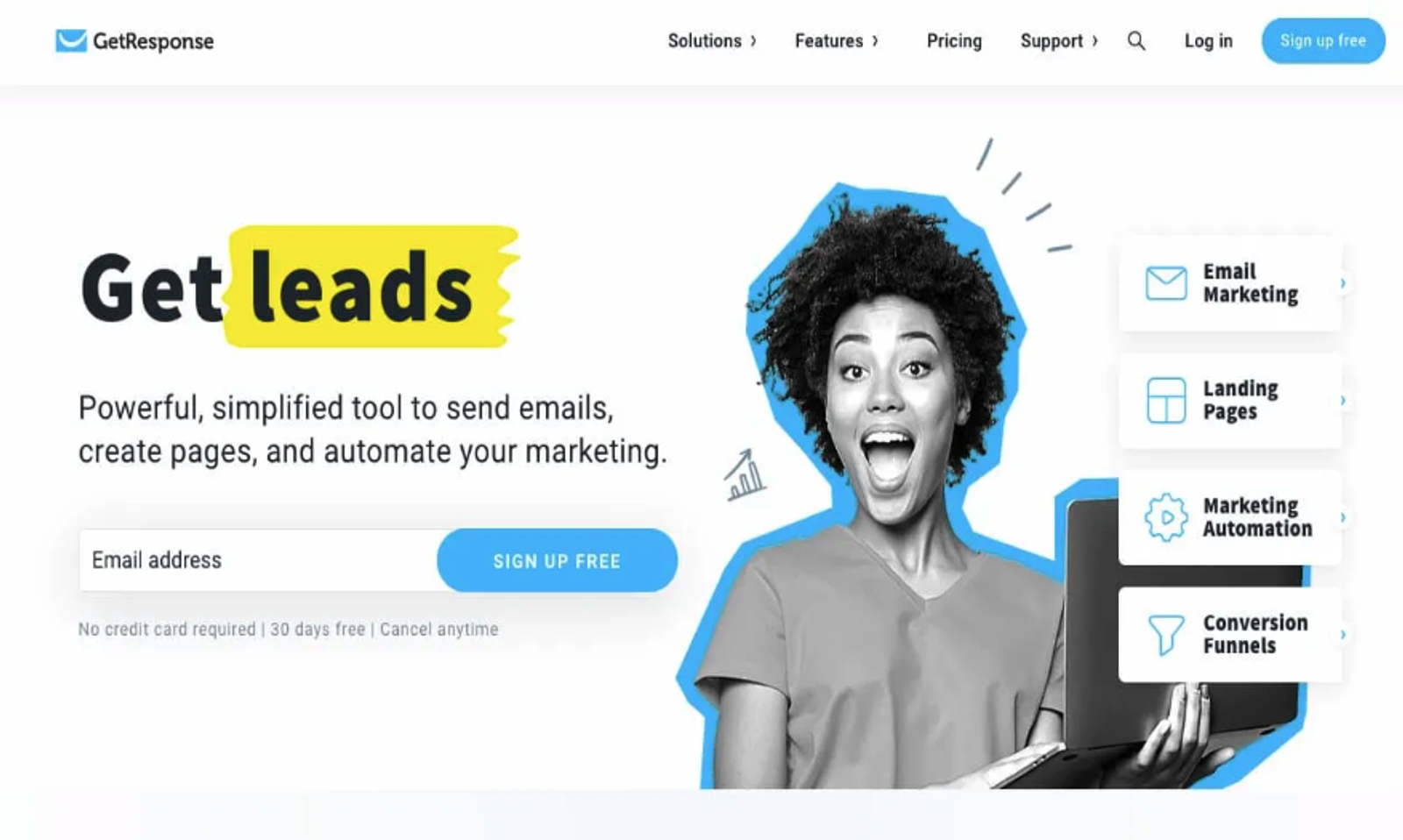
Email automation in GetResponse:
- Email marketing automation: GetResponse provides basic email automation features for cart abandonment and other common situations.
- Email creation: GetResponse offers email templates and a drag-and-drop email builder. Users also gain access to a library of free images and GIFs.
- Engagement scoring: GetResponse offers a CRM with basic contact management and engagement scoring, which allows you to tailor automations based on each prospect’s buying stage in the sales funnel.
3. Sendinblue
Sendinblue promotes itself as an all-in-one marketing platform for small businesses. They offer email marketing and automation, SMS marketing, sign-up forms, landing pages, and a basic sales CRM.
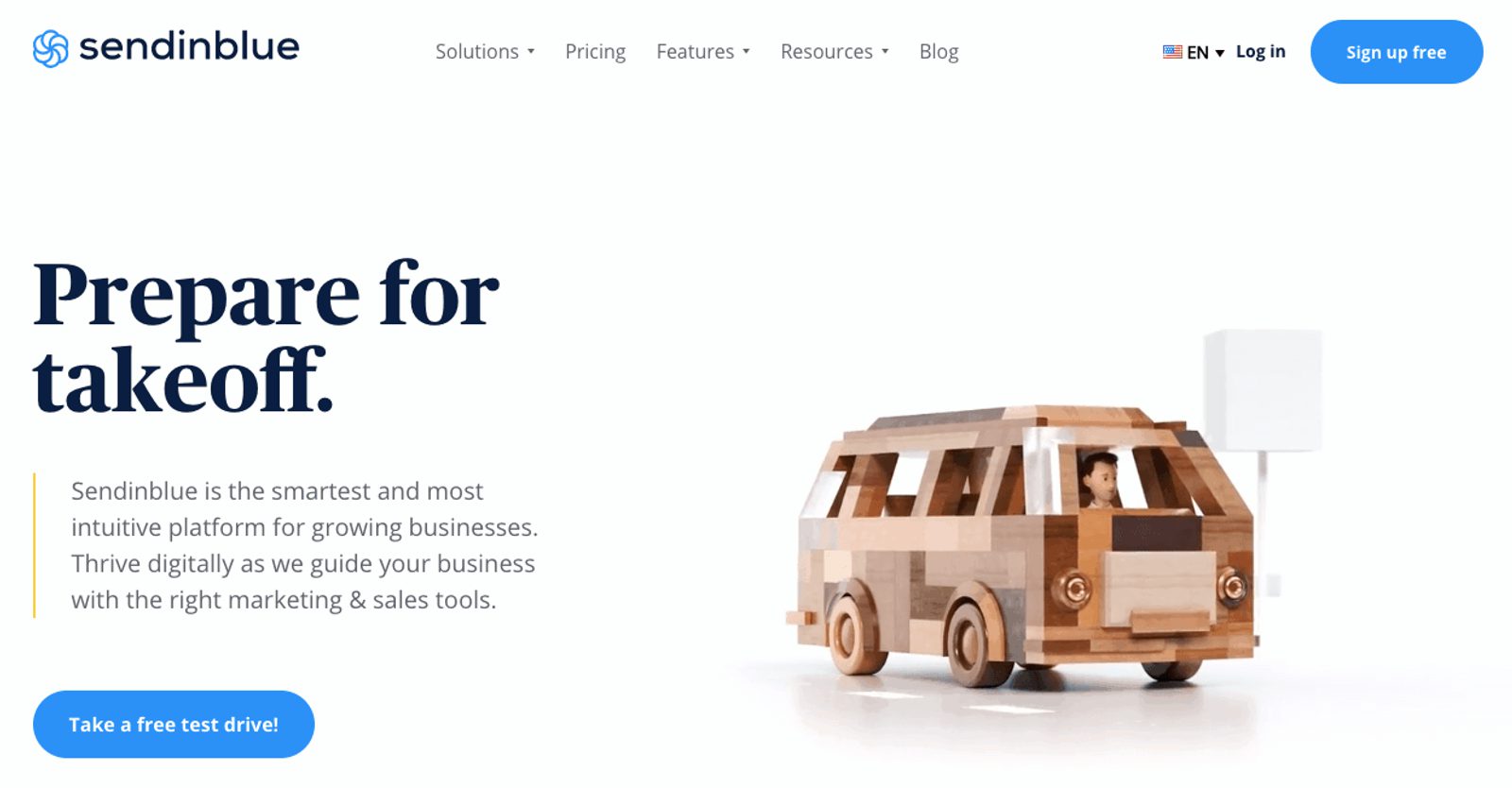
Email automation in Sendinblue:
- Custom email workflows: Within Sendinblue, you can create simple and advanced email automation workflows. The interface isn’t the most intuitive, but you can incorporate lead scoring and other complex details
- Automation A/B Testing: To improve and optimize your email workflows, you can split your audience for A/B tests.
- Transactional emails: Sendinblue offers an email API to connect with the rest of your tech stack and automatically send confirmation emails and other transactional messages.
4. Salesforce Marketing Cloud
Salesforce is among the biggest names in the software-as-service (SaaS) industry. The company is best known for its powerful enterprise CMS, but they also have Marketing Cloud, their digital marketing platform. If you’re already using Salesforce’s CMS, Marketing Cloud might be the easiest path to implementing email automation.

Email automation in Salesforce Marketing Cloud:
- Cross-channel automation: Because Marketing Cloud customers often use other Salesforce products, you can create complex automation incorporating email, web, and mobile interactions.
- Email studio: Within Marketing Cloud, you can build mobile-responsive emails or start with one of their templates.
- Previews and permissions: If you have a larger marketing team, the ability to set user permissions can prevent mistakes and false starts. Marketers can safely preview emails and automations.
5. Adobe Marketo Engage
Adobe is another major player in the software world, and Marketo Engage is the brand’s marketing automation platform. Popular with enterprise and mid-market businesses, Marketo Engage offers email marketing, account-based marketing, and lead management.
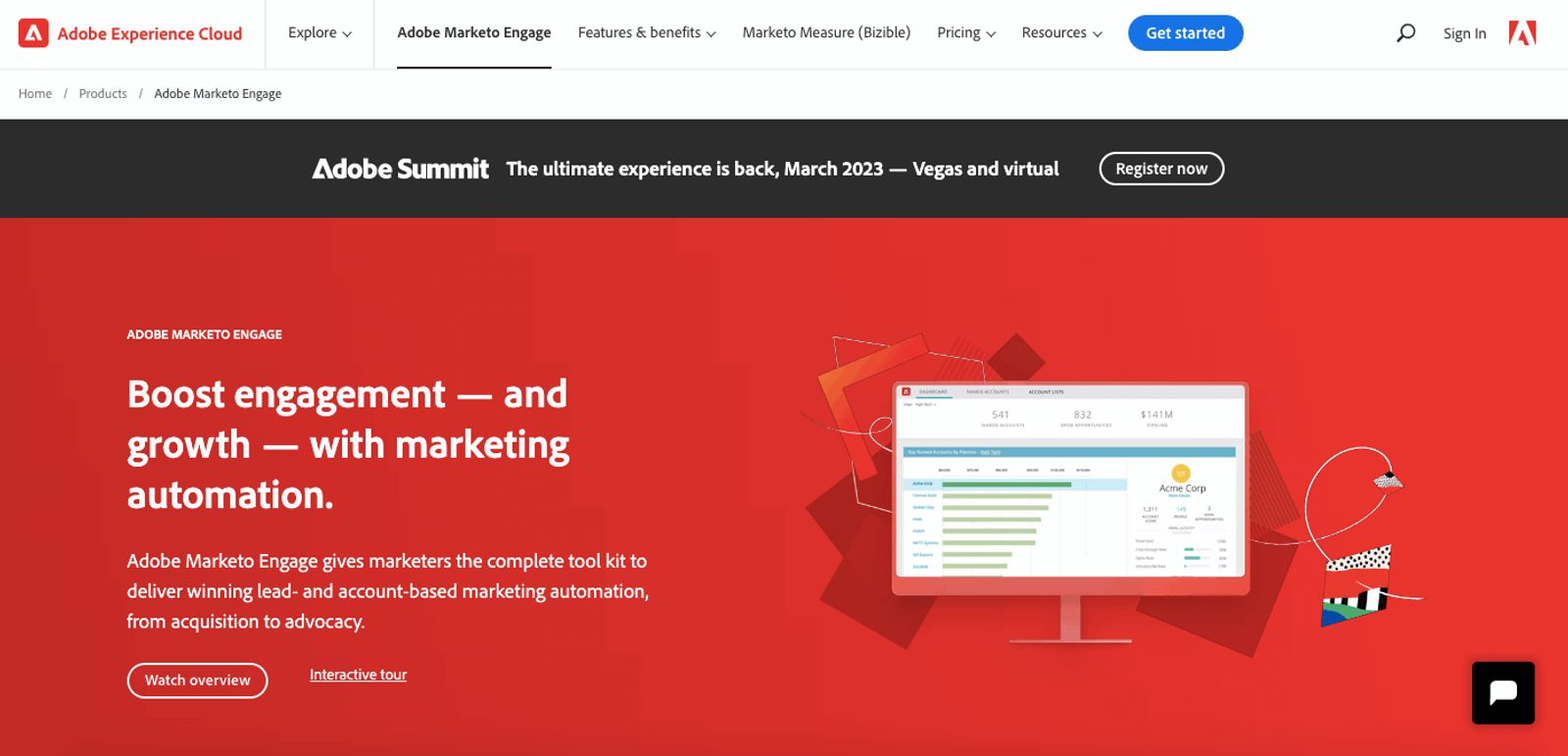
Email automation in Adobe Marketo Engage:
- AI audience building: With their focus on larger companies, Marketo Engage allows you to use artificial intelligence to parse through large email lists and automatically create segments.
- Cross-channel personalization: Along with automatically personalizing emails, Marketo Engage supports website, SMS, and landing page personalization.
- Behavior tracking: With Marketo Engage’s behavior tracking, the system is always learning about what individual customers and audience segments are interested in. This is another valuable tool for larger businesses.
Start building customer relationships with automation workflows
Email automation is a helpful tool to further segment and personalize your email list. Unlike manual broadcast emails, your automations run in the background while you grow your business. As a business owner, you have a lot of demands on your time. So if you’re growing your email list, but feel like you may not be using it to its full potential, email automation is the next best step.
Email automation FAQs
Looking to refine your automated email strategy or explore advanced techniques? Here are quick answers to common questions about email automation.
How can email automation improve customer engagement?
By sending relevant, timely messages based on customer actions or preferences. This makes subscribers feel understood and nurtured—ultimately boosting open rates, click-throughs, and overall engagement.
How can I improve my email automation strategy?
Start with clear goals, then segment your audience by factors like behavior or demographics. Personalize subject lines and content, test different elements (like send times or CTAs), and use metrics to refine your approach over time.
What are some advanced techniques for email automation?
Incorporate dynamic content that adapts to each recipient’s data, experiment with predictive send times powered by AI, or trigger cross-channel workflows (like SMS or CRM updates) to create seamless customer journeys.
Do I need a large email list to benefit from automation?
Not necessarily. Even a smaller list can see significant gains from relevant, automated campaigns. As your list grows, you can scale your automations without adding more manual work.
How do I measure the success of my automated emails?
Track key performance indicators (KPIs) like open rates, click-through rates, and conversions. Monitor unsubscribe rates as well—if they spike, it might be time to adjust your messaging or frequency.